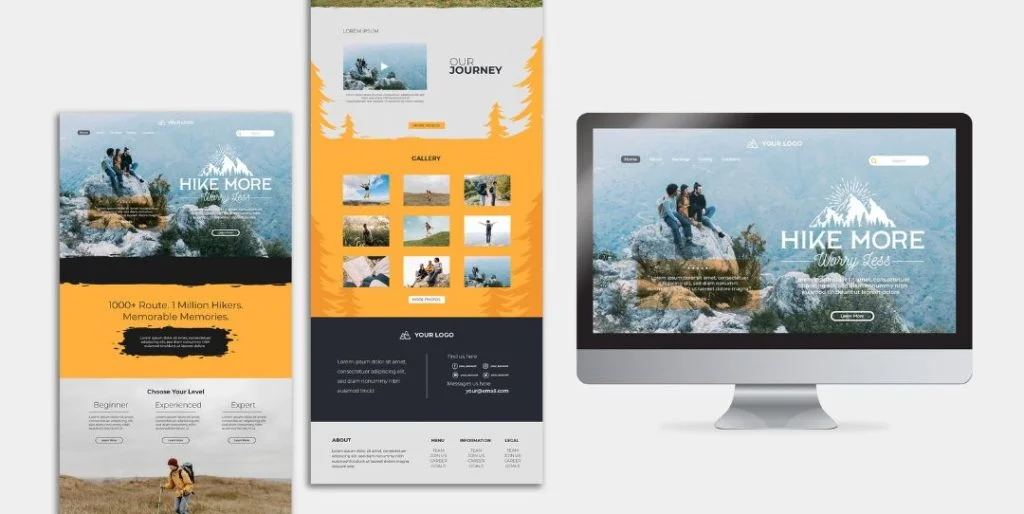Let’s Rule the Web in Malaysia!
Hey there, digital dreamers! In this digital age, having an outstanding website is like having a superpower. Whether you’re an aspiring entrepreneur or a creative professional, your website is the key to unlocking success in Malaysia’s vibrant online landscape. But fear not, because I’ve got your back!
Website Building Process in Malaysia
This guide is your secret weapon, packed with all the juicy details you need to create a website that will leave your competitors green with envy.
1. Understanding the Malaysian Digital Playground (± 3 days)

First things first, let’s get to know the playground we’re stepping into. In this section, I’ll take a thrilling ride through Malaysia’s digital world. I’ll explore internet penetration, mobile usage, and the hottest online activities. It’s like getting a backstage pass to the trends and preferences of the Malaysian audience. Buckle up, folks!
Malaysia has been making some serious strides in this area. With a growing number of internet users, the country has embraced the digital age with open arms. In fact, recent statistics reveal that over 80% of Malaysians are connected to the web. That’s a massive audience waiting to be captivated by your website!
But wait, there’s more! Malaysians have also fallen head over heels for their smartphones. These nifty little devices have become an integral part of their lives, serving as a gateway to the digital realm. In fact, mobile usage in Malaysia has skyrocketed, with a significant portion of the population relying on their phones for all things online. So, when designing a website for the Malaysian audience, it’s crucial to ensure that it looks and functions flawlessly on mobile devices. After all, you wouldn’t want to miss out on reaching this tech-savvy crowd, right?

Now, let’s talk about the hottest online activities in Malaysia. Just like any other group of internet enthusiasts, Malaysians have their own unique online preferences. From social media addicts to avid online shoppers, they’re a diverse bunch with varied interests. So, as you’re designing your website, it’s essential to understand these trends and tailor your design strategy accordingly. Whether it’s creating a visually stunning website to catch the attention of the social media-savvy crowd or optimizing your e-commerce platform for seamless online shopping experiences, catering to the preferences of the Malaysian audience is the key to success.
So, we’ve just scratched the surface of the Malaysian digital playground. Buckle up, because we’re about to embark on an exciting journey where creativity meets technology. In the next sections, I’ll delve deeper into the intricacies of website design in Malaysia and explore strategies to make your website stand out in this dynamic landscape. So, scroll on and get ready to make an impact in the world of Malaysian web design!
2. Finding Your Website’s True Purpose and BFF (Best-Fit Fans) (± 3 days)

Every superhero needs a mission, right? So does your website!
In this section, I’ll dive deep into defining your website’s purpose.
Are you a hero in the e-commerce realm, a master of services, or a guru of information? I’ll help you discover your true calling and identify your best-fit fans in Malaysia.
Get ready to save the day with a website that speaks their language!
Now, defining your website’s purpose is like uncovering the secret identity of your online presence. Are you a mighty hero in the e-commerce realm, ready to offer a seamless shopping experience to Malaysian consumers? Or perhaps you’re a master of services, equipped with the power to provide exceptional solutions to businesses and individuals alike. Alternatively, you might be a guru of information, sharing valuable insights and knowledge to educate and engage your audience. Whatever it may be, identifying your website’s true calling is the first step to success.

But wait, there’s more! Once you’ve discovered your website’s purpose, it’s time to find your very own BFFs – the Best-Fit Fans in Malaysia. These are the individuals or groups who resonate with your mission, share your values, and are genuinely interested in what you have to offer. They are the ones who will champion your website, engage with your content, and ultimately become loyal customers or followers.
Understanding your Best-Fit Fans is crucial because it allows you to tailor your website design, content, and marketing strategies to cater specifically to their needs and preferences. You want your website to speak their language, resonate with their desires, and provide them with a unique and captivating experience. By doing so, you’ll not only attract their attention but also build long-lasting relationships that go beyond a simple transaction.
So, how do you find your Best-Fit Fans in Malaysia? Well, it all starts with research and analysis. Dive into market research to gain insights into your target audience’s demographics, interests, online behavior, and purchasing patterns. A few tools you can use to find what are trending topics on the Internet are Google Trends and Buzzsumo, or AnswerThePublic.
Identify the pain points they face and how your website can solve their problems or fulfill their desires. By understanding your audience on a deeper level, you’ll be better equipped to design a website that captures their attention, addresses their needs, creates a strong connection, and solve a problem.
Remember, your website’s purpose and Best-Fit Fans are the backbone of your digital success. Once you’ve defined your mission and identified your target audience, you can move forward with confidence, creating a website that stands out in the Malaysian landscape. In the next sections, I’ll explore some ‘unfair’ way to get started instead of staring at a blank page with no idea.
3. Going Undercover: Spy on Your Competitors (± 3 days)

It’s time to put on your detective hat and go undercover!
In this thrilling section, I’ll teach you the art of spying on your competitors’ websites.
I’ll uncover their strengths, weaknesses, and the secret sauce that makes them tick. Armed with this insider knowledge, you’ll be able to outshine them all. It’s time to take the spotlight, my friend!
Now, why is it important to spy on your competitors’ websites? Well, think of it as gathering intelligence from the field.
By analyzing what your competitors are doing, you gain valuable insights into what works and what doesn’t in the Malaysian web design scene. You can identify industry trends, innovative features, and design elements that resonate with the local audience. It’s like having a secret weapon in your arsenal that allows you to stay one step ahead of the competition.
If you don’t know who are your competitors yet, just look at the #1 to #3 brand or company in your industry.
So, how do you become a stealthy spy in the world of website design? It all starts with thorough research. Begin by compiling a list of your main competitors in Malaysia. These are the websites that operate in a similar niche or offer similar products and services as your own. Once you have your list, visit each competitor’s website and immerse yourself in their digital world.

Pay close attention to their design choices, user interface, and overall user experience. What elements do they emphasize on their homepage? How do they organize their content? Take note of the colors, fonts, and images they use, as these play a crucial role in creating a visual identity. Analyze the structure of their website, including the navigation menu, categories, and page layouts. Look for features that stand out, such as interactive elements, intuitive forms, or engaging calls-to-action.
But don’t stop there! Dig deeper into their content strategy. What type of content do they offer? Is it informative, entertaining, or both? Take note of the topics they cover, the format they use (blog posts, videos, infographics, etc.), and how frequently they update their content. This will give you insights into the type of content that resonates with the Malaysian audience and keeps them coming back for more.
Now, here’s the secret sauce: Identify your competitors’ strengths and weaknesses. What sets them apart from the crowd? Is it their visually stunning designs, their user-friendly interfaces, or their exceptional customer support? Equally important, identify areas where they fall short. Is their website slow to load, or do they have outdated design elements? Pinpointing these weaknesses will help you identify opportunities to differentiate yourself and offer a better experience to your target audience.

Remember, spying on your competitors is not about copying their every move. It’s about gaining inspiration, learning from their successes and failures, and leveraging that knowledge to create a website that surpasses their offerings. By understanding the landscape and staying updated on the latest trends and best practices, you’ll be equipped to design a website that truly shines in the Malaysian market.
So, put on your detective hat, sharpen your observation skills, and gather intelligence from the field. In the next sections, I’ll uncover strategies to apply these insights to your own website design and create a powerful online presence that leaves your competitors in the dust. Get ready to unleash your creative prowess and dominate the world of website design in Malaysia!
4. Let’s Draw the Blueprint: Planning Your Website’s Structure and Navigation (± 3 days)

Now that you know your mission and have some sneaky intel, it’s time to draw the blueprint for your website. I’ll guide you through the process of planning your website’s structure and navigation like a pro architect. I’ll show you how to create a seamless user experience that will make visitors feel like they’ve discovered the treasure trove of information they were searching for.
Alright, it’s time to draw the blueprint for your website. Now that you know your mission and have gathered some sneaky intel from your competitors, it’s time to plan your website’s structure and navigation like a pro. Get ready to create a seamless user experience that will make your visitors feel like they’ve discovered a treasure trove of information they were searching for.
Just like a well-designed building, a website needs a solid foundation. And that foundation starts with a carefully planned structure. Think of it as organizing the rooms and corridors of your digital space. You want to make sure that your visitors can easily navigate through your website, find the information they need, and take desired actions without getting lost.

So, where do you begin? Start by outlining the main sections or categories of your website. These sections will act as the pillars of your website’s structure. For example, if you’re an e-commerce website, your main sections could include product categories, a shopping cart, and a checkout page. If you’re a service-based business, your sections might revolve around different service offerings, testimonials, and a contact page.
Once you have your main sections in place, it’s time to consider the subpages or subcategories that fall under each section. This is where you’ll organize your content in a logical and intuitive manner. Imagine you’re a visitor trying to find specific information or products on your website. How would you want it organized to make your journey smooth and enjoyable?
When planning your website’s structure, it’s essential to strike a balance between simplicity and depth. You want to provide enough content and information without overwhelming your visitors. Consider using dropdown menus, breadcrumbs, or related links to help users navigate to specific pages or explore related topics.
Remember, the goal is to guide your visitors effortlessly and make their browsing experience a breeze.
Now, let’s talk about navigation. Just like street signs and maps guide us through a city, navigation menus guide users through your website. You want to make sure your navigation is clear, intuitive, and accessible from any page. Typically, websites use a top navigation menu or a sidebar menu for easy access to different sections and pages. If there are too many items in your menu, consider stacking them up in a hamburger menu.

When designing your navigation, keep it simple and concise. Use clear and descriptive labels for each menu item so that visitors can understand where they will be taken when they click. Additionally, consider including a search bar to allow users to quickly find specific content or products. This can be a lifesaver for users who are looking for something specific and don’t want to spend time digging through various pages.
As you plan your website’s structure and navigation, always put yourself in the shoes of your visitors. Think about their goals, their needs, and how they would want to explore your website. User experience (UX) is paramount, and by designing a seamless and intuitive navigation system, you’ll create a very positive experience for your visitors. Afterall, people like to find things easily and don’t like to dig deep for it.
So, put on your architect’s hat and start drawing the blueprint for your website. In the next sections, I’ll explore how to bring your design ideas to life and create content that will captivate your audience. Get ready to turn your blueprint into a masterpiece and make your mark in the world of website design in Malaysia!
5. Words that Wow: Crafting Engaging and User-Friendly Content (± 15 days)

Okay, wordsmiths, this one’s for you! In this section, I’ll unleash the power of words that wow. I’ll reveal the secrets of crafting engaging content that will make your Malaysian audience fall head over heels for your website. From catchy headlines to smooth storytelling, I’ve got you covered. Get ready to make your words dance on the screen!
When it comes to website design, content plays a crucial role in capturing the attention and interest of your visitors. It’s the fuel that powers your website, creating a connection between you and your audience. To create content that wows, you need to understand the preferences and needs of your Malaysian audience.
First and foremost, let’s talk about headlines. Your headline is the first impression you make on your visitors, and it needs to be attention-grabbing. Think of it as a hook that entices your audience to dive deeper into your content. Use captivating, concise, and relevant headlines that pique curiosity and convey the value your website offers. A well-crafted headline can make all the difference in whether a visitor decides to explore further or move on. Believe me, headlines weight 50% of your entire page, that’s how important it is.

Beyond headlines, the body of your content should be engaging and user-friendly. Break down your content into bite-sized chunks, using subheadings, bullet points, and short paragraphs. This makes it easier for readers to skim through and find the information they’re looking for. Remember, the attention span of online users is so short, so make your content easily scannable, readable and visually appealing.
Now, let’s talk about storytelling. Humans are natural storytellers, and storytelling has the power to captivate hearts and minds. Incorporate storytelling techniques into your content to create an emotional connection with your audience.
Share real-life experiences, case studies, or testimonials that resonate with your target audience. Show them how your products or services have made a difference in the lives of others. By weaving a compelling narrative, you’ll create a memorable experience that keeps visitors engaged and eager to learn more.

Additionally, consider incorporating local nuances and cultural references into your content. As you know, Malaysia is a diverse country with its own unique customs, traditions, and languages. By embracing these aspects in your content, you’ll show your audience that you understand and appreciate their culture. This creates a sense of familiarity and builds trust, making your website feel like a welcoming space tailored specifically for Malaysians.
Lastly, don’t forget the power of call-to-action (CTA) buttons. These are the signposts that guide your visitors to take desired actions. Make your CTAs clear, straight-forward, and user-friendly. Use action-oriented language that encourages users to click, sign up, buy now, or engage with your website. Place your CTAs strategically throughout your content and make sure they stand out from the rest of the page, whether it’s by a contrasting color or size.
Remember, crafting engaging and user-friendly content is an art form. It requires a deep understanding of your audience, their preferences, and the ability to captivate their attention. By using powerful headlines, incorporating storytelling techniques, and optimizing your content for scannability, you’ll create a delightful reading experience that keeps your visitors coming back for more.
So, let your words wow and your content shine. In the next sections, I’ll explore the visual aspects of website design and how to create a visually stunning interface that complements your engaging content. Get ready to make your website a feast for the eyes and the mind in the world of website design in Malaysia!
6. Colors, Fonts, and All That Jazz: Choosing an Aesthetically Pleasing Design (± 3 days)

It’s time to put on your designer hat and make your website a visual masterpiece! In this section, I’ll explore the world of colors, fonts, and all that jazz. I’ll guide you through the art of choosing an aesthetically pleasing design that will make eyes pop and hearts skip a beat. Say goodbye to dull and hello to fabulous!
When it comes to website design, aesthetics play a crucial role in capturing attention, evoking emotions, and creating a memorable experience for your visitors. The right combination of colors and fonts can transform a plain webpage into a stunning visual delight. So, let’s start with colors.
Colors have the power to convey emotions, set the tone, and create a cohesive visual identity for your website. In Malaysia, cultural diversity and preferences may influence color choices. Consider incorporating colors that resonate with the local culture or align with the image you want to portray. For example, vibrant and warm tones like red, orange, or yellow can evoke energy and passion, while cooler tones like blue and green can convey a sense of calm and trustworthiness. Experiment with different color palettes and find the perfect combination that reflects your brand personality and appeals to your target audience.
I talk more in-depth about color pallete and color combination in this article.
Next up, fonts. Typography is an essential element of design that sets the tone and enhances readability. Choose fonts that align with your brand’s personality and are legible across different devices and screen sizes. In Malaysia, it’s essential to consider font styles that are easily readable for the local audience. Sans-serif fonts are generally preferred for online content due to their clean and modern look. However, don’t be afraid to mix and match fonts to create contrast and hierarchy in your design. Use a combination of headline fonts and body fonts to create visual interest and guide the reader’s eye through your content.

Now, let’s talk about the overall design aesthetic. Consistency is key when it comes to creating a visually pleasing website. Maintain a cohesive design language throughout your website by using consistent colors, fonts, and graphic elements. This helps create a sense of unity and professionalism. Balance is also crucial. Find the right balance between white space and content, ensuring that your website feels clean and organized. Avoid clutter and allow your design elements to breathe. This will enhance readability and create a visually pleasing experience for your visitors.
Additionally, consider incorporating visual elements that are unique to Malaysia or resonate with the local audience. This can include illustrations, photographs, or graphics that depict local landmarks, cultural symbols, or traditional motifs. From our tall Peronas Twin Towers, to our local delicacy Nasi Lemak. By infusing these elements into your design, you create a sense of connection and familiarity with your Malaysian visitors.
Remember, aesthetics should not overshadow functionality. Your design choices should enhance the user experience and make it easy for visitors to navigate your website. Keep in mind the principles of responsive design, ensuring that your website looks great and functions seamlessly across various devices, from desktops to smartphones.
So, let your creativity soar and design a website that mesmerizes your visitors. In the next sections, I’ll delve into the technical aspects of website design and explore how to cater your business to different devices. Get ready to turn your website into a stunning work of art in the world of website design in Malaysia!
7. Mobile-Friendly Magic: Optimizing for Mobile Responsiveness (± 10 days)

In a world where everyone’s glued to their smartphones, you can’t afford to ignore mobile-friendliness. Fear not, because I’ve got the secret recipe for mobile-friendly magic! In this section, I’ll show you how to optimize your website for mobile responsiveness. Get ready to make your website look amazing, whether it’s viewed on a massive desktop screen or a tiny smartphone. I’ll make sure your website shines in every size!
Mobile responsiveness is the key to creating a delightful user experience for your visitors who access your website on their mobile devices. With mobile internet usage skyrocketing, it’s vital to ensure that your website adapts seamlessly to different screen sizes and resolutions. You want your visitors to have the same amazing experience, whether they’re browsing on a desktop computer, a tablet, or a smartphone.
So, how do you achieve mobile-friendly magic? The first step is to choose a responsive design framework or theme for your website. This means that the design elements, layout, and content will automatically adjust to fit the screen size of the device being used. Responsive design ensures that your website maintains its visual appeal and functionality regardless of the device your visitors are using.
When optimizing for mobile responsiveness, it’s important to prioritize simplicity and ease of use. Mobile screens are smaller, and users interact with their fingers instead of a mouse. Ensure that your navigation menus are easily accessible and that buttons and links are large enough to be tapped with ease. Minimize scrolling and make sure that important information is visible without the need for excessive swiping or zooming.
Pay close attention to the loading speed of your mobile website. Mobile users are often on the go and expect fast-loading pages, not to mention slow connection speed at certain areas. Compress images and optimize code to reduce file sizes and improve loading times. A fast-loading website not only enhances the user experience but also plays a crucial role in search engine optimization, as search engines prioritize mobile-friendly and fast-loading websites.

Keep in mind that mobile users have different browsing habits and goals compared to desktop users. They may be searching for quick information, seeking to complete a task, or looking for location-based services. Ensure that your mobile design focuses on these unique user needs and streamlines the user journey. Simplify forms and checkout processes, prioritize essential content, and make it easy for users to take action on their mobile devices.
Testing is a crucial step in optimizing for mobile responsiveness. It’s not enough to assume that your website looks great on mobile devices. Test it across various devices and screen sizes to ensure consistent and pleasing visual experiences. Make adjustments as needed to achieve the desired result. You can also use an online tool to preview how your website looks like in different devices and resolution, though they aren’t always reliable.
By optimizing your website for mobile responsiveness, you’re not only providing a better user experience but also staying ahead of the competition. Mobile users appreciate websites that are easy to navigate, load quickly, and display beautifully on their devices. So, don’t miss out on the mobile-friendliness magic and make sure your website shines in every size!
In the next section, I’ll dive into the realm of user experience, where the true magic happens. I’ll explore how to create intuitive and delightful interactions that leave a lasting impression on your visitors. Get ready to take your website design to the next level with an exceptional user experience in the world of website design in Malaysia!
8. User Experience: Where Magic Happens (± 10 days)

Let’s dive into the realm of user experience (UX) where magic happens! In this section, I’ll show you how to create intuitive interfaces that will make users say, “Wow, this website gets me!” I’ll unravel the secrets of user personas, wireframing, and prototyping. Say goodbye to confusion and hello to a website that feels like a warm hug.
User experience (UX) focuses on understanding and meeting the needs of your website’s visitors. It’s about creating an interface that is not only visually appealing but also intuitive and easy to navigate. A great user experience goes beyond aesthetics; it’s about ensuring that your website provides value, solves problems, and leaves a positive impression on your users.
To kickstart the UX design process, it’s important to develop user personas. User personas are fictional representations of your target audience, based on research and data. They help you understand the goals, behaviors, and preferences of your users. By identifying your users’ needs and pain points, you can tailor your website’s design and content to address them effectively. User personas serve as a guiding compass throughout the design process, ensuring that your decisions align with your users’ expectations.

Once you have a clear understanding of your target audience, it’s time to create wireframes. Wireframes are simplified visual representations of your website’s layout and structure. They help you outline the placement of different elements, such as navigation menus, content sections, and call-to-action buttons. Wireframes act as a blueprint for your website, allowing you to focus on the overall structure and flow before diving into the finer design details. They serve as a visual guide, ensuring that your website’s functionality and user flow are well thought out.
After wireframing, it’s time to bring your design to life through prototyping. Prototypes are interactive mock-ups of your website that allow users to experience the design and functionality firsthand. Prototyping helps you identify any usability issues, gather feedback, and iterate on your design before the development phase. By testing your prototype with real users, you can gain valuable insights into how they interact with your website and make necessary improvements to enhance the user experience.

During the UX design process, it’s crucial to prioritize simplicity, clarity, and consistency. Simplify your navigation menus and make it easy for users to find what they’re looking for. Use clear and concise language in your content, avoiding jargon or complicated terminology. Maintain consistency in the design elements, such as colors, fonts, and button styles, throughout your website. Consistency helps users build familiarity and navigate your website with ease.
Remember, the ultimate goal of user experience design is to create a website that feels like a warm hug to your visitors. You want users to feel welcomed, understood, and guided as they explore your website. By focusing on their needs, preferences, and behaviors, you can create an experience that resonates and leaves a lasting positive impression.
In the next section, I’ll delve into the tech behind the scenes and explore how to choose the right technology to power your website. Get ready to make informed decisions and bring your website to life with the perfect technological foundation in the world of website design in Malaysia!
9. The Tech Behind the Scenes: Choosing the Right Technology (± 10 days)
Behind every great website, there’s some mind-blowing technology. In this section, I’ll demystify the tech world and help you choose the right technology for your website. From content management systems (CMS) to custom coding, I’ll be your tech superheroes. Together, I’ll build a website that’s powerful, flexible, and ready to conquer the online universe.

When it comes to choosing the right technology for your website, it’s important to consider your specific needs and goals. One popular option is to utilize a content management system (CMS) like WordPress, Joomla, or Drupal. These CMS platforms provide a user-friendly interface that allows you to manage and update your website’s content without extensive technical knowledge. They offer a wide range of themes, plugins, and extensions that can enhance the functionality and design of your website. CMS platforms are particularly useful if you require frequent content updates or if you plan to have multiple contributors working on your website.
On the other hand, if you have unique requirements or want complete control over your website’s design and functionality, custom coding might be the way to go. This option allows you to build a website from scratch, tailored specifically to your needs. Custom coding gives you the freedom to implement any feature or design element you desire, but it requires technical expertise or the assistance of a professional web developer. It’s a great choice if you have complex functionality requirements or if you want a completely bespoke website that stands out from the crowd.

Another important consideration is the scalability and future-proofing of your chosen technology. As your business grows, you may need to expand your website’s features or accommodate increased traffic. Ensure that the technology you choose is scalable and can handle your future needs. It’s also important to consider the availability of support and updates for the chosen technology. Opt for technologies that have active developer communities and regular updates to ensure security, stability, and compatibility with evolving web standards.
When deciding on the tech behind the scenes, take into account factors such as ease of use, flexibility, scalability, security, and maintenance requirements. Assess your budget and resources, and weigh the pros and cons of each technology option. If you’re unsure or have limited technical expertise, it’s wise to consult with a web developer or agency to help you make an informed decision.
Ultimately, the right technology will empower you to create a website that meets your unique needs and goals. It will provide a solid foundation for your online presence and ensure that your website performs optimally while offering a seamless user experience.
In the next and final section, I’ll cover the exciting phase of testing and launching your website. I’ll walk through essential steps to ensure your website is error-free, optimized, and ready to make a splash in the online world. Get ready to take that final leap and launch your website with confidence in the world of website design in Malaysia!
10. Ready, Set, Launch: Testing and Launching Your Website (± 5 days)

We’re almost there, my friend! It’s time to put on the final touches and get ready to launch your masterpiece. But before the big moment, I’ll show you the importance of testing. I’ll guide you through the testing process, ensuring your website is flawless and ready to rock. Then, I’ll unveil the secrets of launching your website like a pro. Get ready to shout from the rooftops, “I’m here, world!”
Testing your website before launching is a crucial step that ensures a smooth and error-free experience for your visitors. It allows you to catch any bugs, broken links, or design inconsistencies that might have slipped through during the development process. There are several areas you’ll want to pay attention to during testing.
First, check for any technical issues. Test your website across different browsers (such as Chrome, Firefox, and Safari) to ensure compatibility. Pay close attention to how your website looks and functions on different devices, including desktop computers, laptops, tablets, and smartphones. Ensure that all the pages and features load correctly, images are displayed properly, and forms and interactive elements are working as intended.

Next, review your website’s content with a critical eye. Check for any spelling or grammatical errors, awkward sentences, or formatting issues. Ensure that the content is clear, concise, and engaging for your target audience. Get a proof-reader for best results. Test all the links on your website to make sure they lead to the correct pages and external websites.
Don’t forget to test your website’s performance and speed. A slow-loading website can turn visitors away, so optimize your images, minimize code, and utilize caching techniques to improve loading times. I usually use GTMetrix, but feel free to use Google Page Speed Insights. Test the website’s load speed on different internet connections to ensure a smooth experience for users with varying internet speeds.
Once you’re satisfied with the testing phase, it’s time for the grand finale: launching your website. But before you hit that publish button, double-check a few things. Make sure your website’s domain name is properly connected to your hosting provider and that all the necessary DNS settings are in place. If you have an SSL certificate, ensure that it’s installed correctly to provide a secure browsing experience for your users.
Consider setting up website analytics and tracking tools, such as Google Analytics, to monitor your website’s performance and gather valuable insights about your visitors. These tools will help you understand how people interact with your website, which pages are popular, and how they found your website in the first place. This information will be invaluable for optimizing your website’s performance and marketing strategies in the future.
Finally, when the moment arrives, take a deep breath, and confidently hit that launch button. Congratulations! Your website is now live and ready to make its mark on the digital landscape. Spread the word about your new website through your social media channels, email newsletters, and any other marketing avenues available to you.

Remember, launching your website is just the beginning of an ongoing journey. Regularly monitor your website’s performance, update your content, and adapt to your audience’s evolving needs. Stay proactive in maintaining and improving your website to ensure its long-term success.
Now that you’re equipped with the knowledge and steps to create a remarkable website, it’s time to address some common questions and concerns in the FAQ section. Let’s dive in and address any lingering doubts you may have.
FAQs (Frequently Asked Questions)
1. How long does it take to design a website in Malaysia?
Ah, the million-dollar question! The web development timeline depends on various factors, like the complexity of your website and the collaboration with your web development team.
So, how long does it take to design a website? Simple websites can be up and running in a few weeks, while complex e-commerce sites might take a few months. But hey, good things take time, right?
2. What’s the damage? How much does it cost to design and develop a website in Malaysia?
Ah, the budget talk! The cost can vary depending on your website’s complexity and the level of customization you desire. Simple websites can cost anywhere from RM3,500 to RM6,000, while more complex e-commerce websites can go above RM10,000. But remember, this investment is your ticket to online success!
3. Can I be my own website designer and developer? Do I really need a pro?
You’re a go-getter, aren’t you? While it’s possible to spend your time to design and develop your website using platforms like WordPress and Wix, keep in mind that professional expertise can take your website to the next level, not mentioning the time you saved from making errors on your own. Designing a website that stands out requires a mix of technical knowledge and creative flair. You’ve got this, but don’t hesitate to call in the pros if needed!
4. What are the must-have elements for an outstanding website?
Ah, the secret sauce of success! An outstanding website needs clear navigation that even a lost pirate can follow. Engaging content that makes visitors go “Wow!”. Fast load times that leave no room for boredom. Good combination of colors to make people feel plesant to view. Responsive design that looks smashing on any device. And last but not least, effective call-to-actions (CTAs) that make visitors say, “Where do I sign up?”
5. What are some common web design mistakes I should avoid like the plague?
Ah, the deadly mistakes! Beware of using too many different fonts and colors that clash like bitter enemies. Steer clear of cluttered layouts that confuse visitors like a maze. Avoid slow load times that make people nap like a sloth. Oh, and don’t forget about poor mobile optimization that’s like trying to fit a whale into a goldfish bowl. And remember, clear navigation is your guiding light!
6. How can I make my website a hit in the Malaysian market?
Ah, the Malaysian touch! To win hearts in Malaysia, sprinkle your website with local flavor. Consider providing dual languages and incorporating familiar imagery and symbols. Oh, and make sure your website resonates with the preferences and values of the Malaysian audience. Be their best friend, and they’ll love you forever!
Conclusion: Get Ready to Conquer the Web in Malaysia!
Congratulations, dear adventurer! You’ve reached the end of my epic guide. Armed with this knowledge, you’re now equipped to create a website that wows, captivates, and conquers the hearts of the Malaysian audience. So go forth, unleash your creativity, and rock the online world like the web-savvy hero you are!
When it comes to creating a remarkable online presence, Jumix stands out as the best web design company in Malaysia. Our team of experienced professionals combines technical expertise with innovative design to deliver websites that not only look stunning but also function seamlessly. We understand that your website is your digital storefront, and we take pride in crafting custom solutions tailored to your unique needs.
Sanz Teoh
Latest posts by Sanz Teoh (see all)
- Self-Hosting or Web Hosting in Malaysia: Which One’s Worth It? - June 30, 2025
- 7 Signs You Need a Better Web Developer Company Malaysia - June 25, 2025
- The 7 Must-Have Website Features That Bring More Patients to Your Beauty Clinic - June 15, 2025



